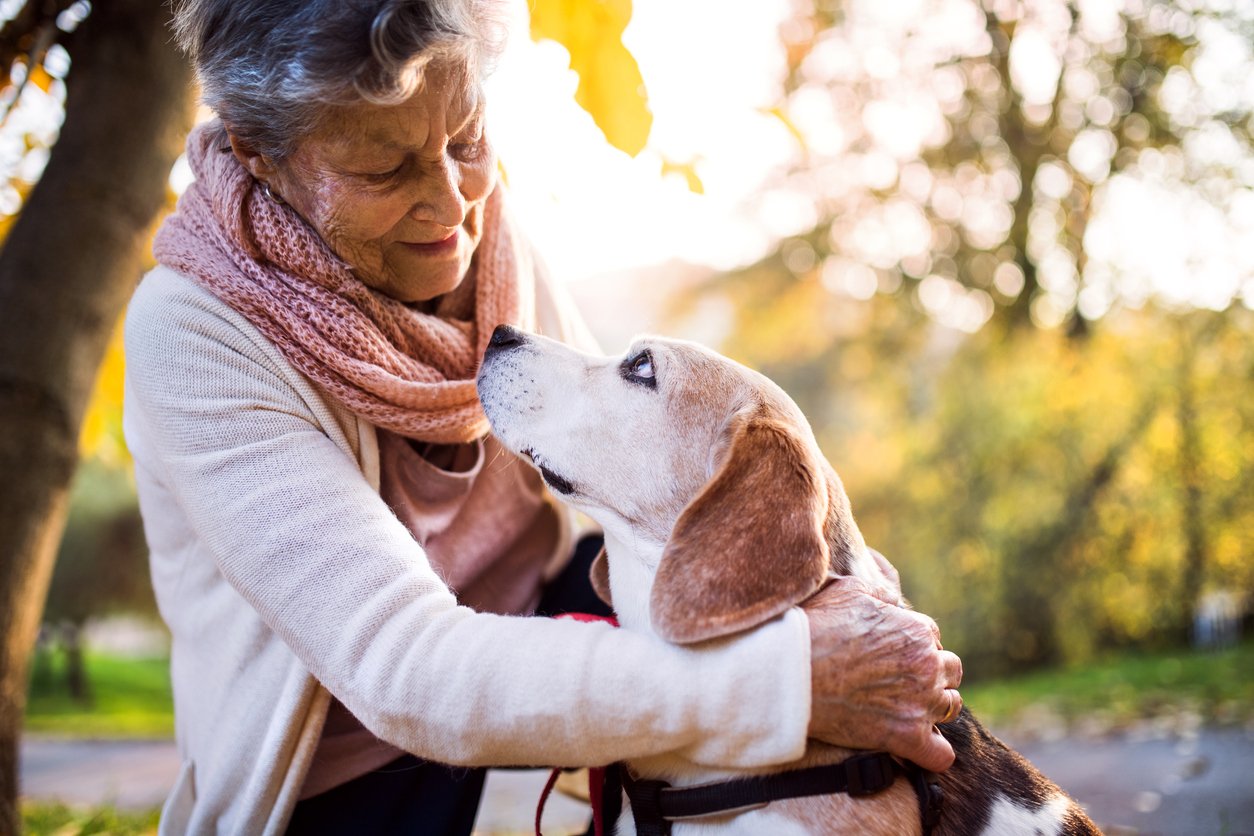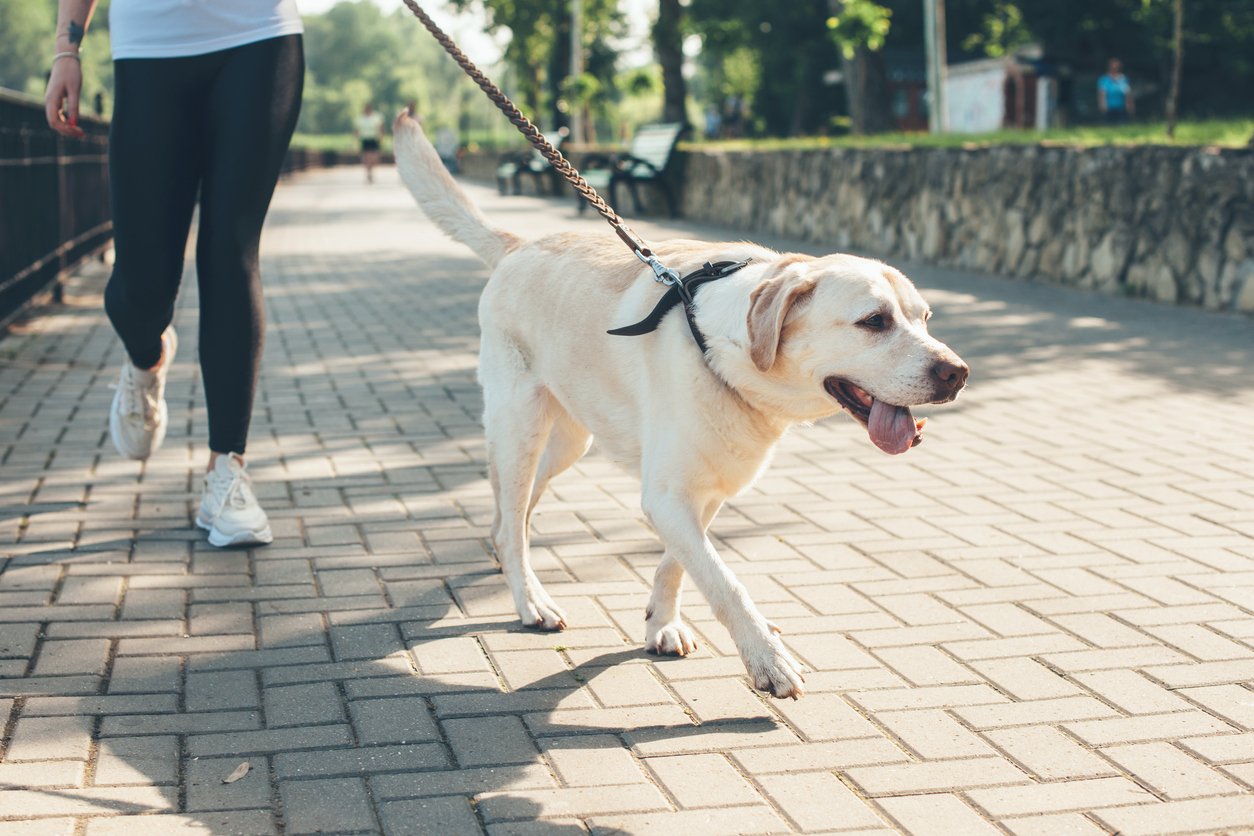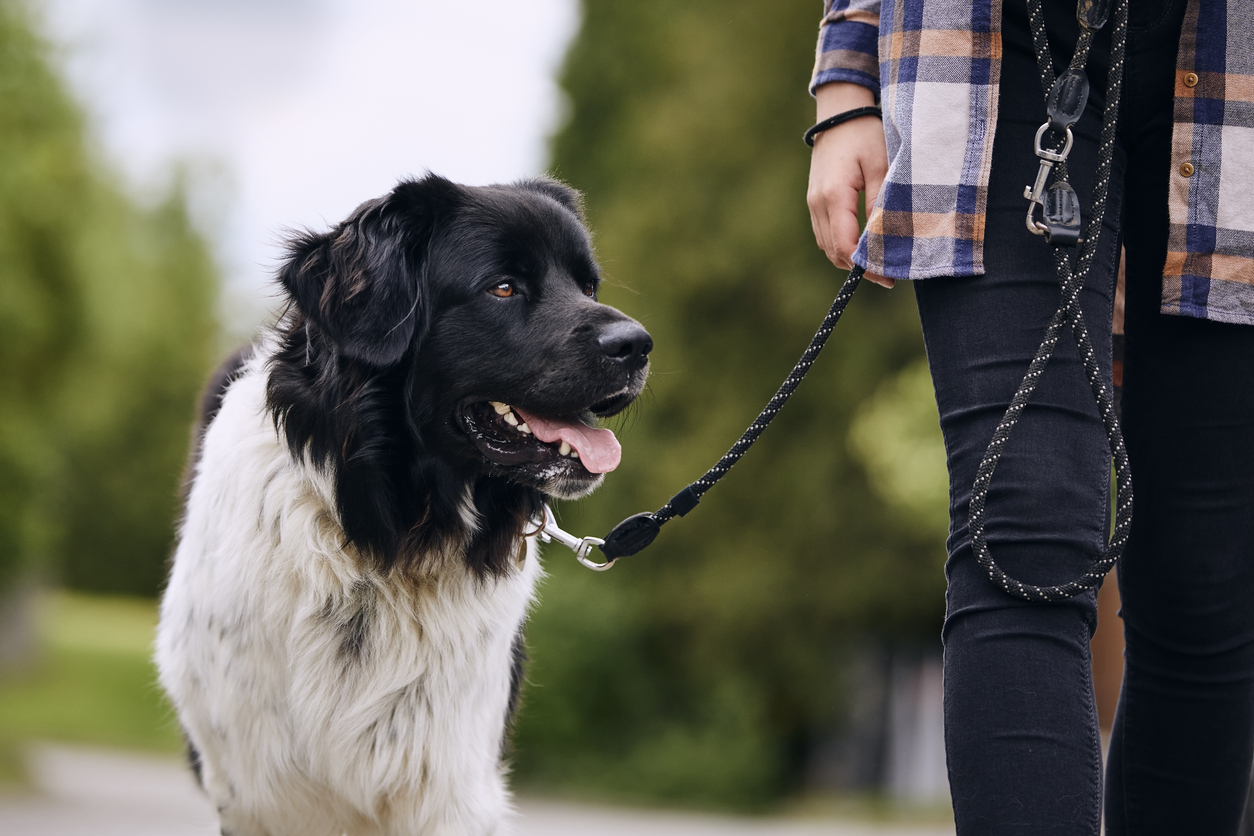Table of Contents
Do you have a dog with hip dysplasia? If so, you know how challenging it can be to walk your dog. Dogs with hip dysplasia can often have difficulty with simple movements, which includes walking and even standing. This can make a dog walking with hip dysplasia a challenge for even the most experienced pawrent, but there are some things that you can do to help your pup enjoy their time outside more and reduce the stress on their hips when a dog laying down with hip dysplasia wants to take a load off.
From modifications in the home, to adding joint supplements, and changing exercise routines, a dog walking with hip dysplasia can still live a happy, rich life—you just need to know how to help! In this post, we’ll break down the ways you can make life more comfortable for your dog walking with hip dysplasia.
How to Identify a Standing Dog With Hip Dysplasia
Sometimes, spotting hip dysplasia in dogs is as simple as checking out the stance of your dog.
As you can see in the diagram above, in comparison to the healthy dog (left), the dysplastic dog (right) has a squarer, wider-set pelvis. You may also notice an especially narrow or wide stance, depending on the grade of your dog’s subluxation of the hips.
A healthy, non-dysplastic dog has a certain stance and gait, and through a gait analysis, your vet can determine whether or not your dog is walking with hip dysplasia or not.
There are 4 basic gaits that can be checked if a dog is walking with hip dysplasia, and they each have an ideal or healthy appearance, as outlined in the table below.
|
Dog Gait |
Healthy Appearance |
|
Walk |
Each foot lifts off the ground one at a time in a regular sequence. Three paws always support the body. |
|
Trot |
Both front and hind legs of the dog move forward together. The weight is transferred between the pairs of legs, and the legs are suspended in midair for a short period of time. |
|
Canter |
One rear leg strikes the ground first, followed by the other rear leg and opposite front leg together, then the fourth leg. |
|
Gallop |
Generally, the left front limb hits the ground first, followed by the right front limb, followed by a period where no paws touch the ground, followed by the left hind limb, and finally the right hind limb. |
Dogs walking with hip dysplasia will have changes that make their abnormal gait obvious, especially in the hind limbs:
- In order to offset the weight from the hind end, the head and neck are extended and lowered
- When observing the gait from behind, the hip on the unaffected side appears lower due to the hip that "hikes" on the lame side
- Their tail rises when the lame leg touches the ground
- Their hind end swings to one side more when walking
- Lameness or refusal to put any weight on the affected limb
- Tail swinging more to one side than the other
In addition to unusual stance and gait, hip dysplasia can be detected by an abnormal sitting posture. Dogs with hip dysplasia will often be seen shifting their weight away from their hips when they are laying or sitting down. That’s not to say every dog who gets a little uncomfortable or tends to be active and doesn’t like to stay still for long periods of time has hip dysplasia.
Seeing a combination of gait abnormalities, changes in their stance, and in the way they sit—it’s probably safe to say that there is something going on with their hips, and you may have a dog walking with hip dysplasia on your hands. The best thing to do is pay a visit to your vet and get a proper assessment done.
5 Tips for Dog Walking With Hip Dysplasia

There’s nothing like a case of the zoomies! Even for dogs with hip dysplasia, burning off some steam and getting exercise is important.
Exercise is a crucial part of the care for dogs with hip dysplasia. It helps maintain muscle strength and joint range of motion, as well as decrease inflammation and pain.
However, you should never force your dog to exercise if it is in pain. It is important to pay attention to your dog's body language: if they are limping or avoiding movement, then they are probably in pain and should not be forced to exercise.
With that disclaimer out of the way, let’s get to those tips!
Tip #1: Limit Exercise Time
Especially for certain breeds where hip dysplasia is more common, limiting exercise early on to avoid damage to their hips is essential.
That’s because some large breeds most prone to hip dysplasia, and that list includes:
- Newfoundlanders
- Labrador Retrievers
- Golden Retrievers
- Saint Bernards
- German Shepherds
- Rottweiler
Hip dysplasia is thought to be due to abnormal development of the hip joint during early puppyhood. The joint becomes loose and unstable over time as a result of this abnormal development. Young large breed dogs can be more prone to dog hip dysplasia, due to excessive growth rate during puppyhood. This excessive growth rate puts increased pressure on developing joints such as those in the hips and elbows, which can cause damage that leads to arthritis later in life.
The bottom line? Skip hard hikes, running, frisbee, and other more intense exercises with your young, large breed pup or adult dog.
Note joint supplements, like TRI-ACTA for Pets, help to support the development of joint structures during growth and maturation and can reduce the chances of developing dysplasia later in life.
Tip #2: Opt For Slow and Gentle Walks
When your dog is walking with hip dysplasia, you want to opt for slow and gentle walks. Avoid jogging or running with your dog because these activities can put too much strain on the joints and muscles.
This can be the difference between a painful, frustrating experience for pups with hip dysplasia, and a fun afternoon outdoors.
Here's what else you need to know about gentle walks for dogs with hip dysplasia:
- Use a harness instead of a collar when walking your dog who has hip dysplasia. A harness distributes the weight across your dog's body rather than just on his neck and front legs, which can make walking easier on him if he has arthritis in his back end (where most dogs with hip dysplasia have pain). Harnesses also help prevent pulling while walking – a common symptom in dogs with hip dysplasia—so it's easier on both of you!
- Be sure there are no obstacles like rocks or tree roots along your route so that you don't have to worry about your pup getting caught up or tripping over them while walking your dog who has hip dysplasia
Tip #3: Try Alternatives to Running and Walking
Dogs need exercise every day to stay healthy. And if your dog has hip dysplasia, it's even more important that they get to exercise on a regular basis. But sometimes, a walk is just not going to cut it for dogs with severe painful cases of hip dysplasia.
Good news! Dogs can be exercised in a variety of ways, and you don’t just have to get steps in to get moving.
Some alternatives to running or dog walking with hip dysplasia include:
- Swimming
- Games
- Physical therapy exercises
- Underwater treadmill walks (hydrotherapy)
- Puzzle games
Just remember – if your dog shows signs of pain or discomfort after exercising, stop immediately and consult with your veterinarian before attempting any other exercise.
Tip #4: Incorporate a Dog Hip Brace
There are many ways you can help your dog live comfortably with hip dysplasia. One way is by incorporating a dog hip brace into their daily routine.
A dog hip brace is a type of sling or harness that helps reduce pain and swelling in the hips. It also helps stabilize the joint so it moves correctly during activity.
The use of these braces has many benefits:
- Helps control pain caused by osteoarthritis
- Reduces the risk of dislocation and injury to soft tissue and nerves around the hip joint
- Helps prevent further deterioration of joints affected by hip dysplasia
Be sure to consult your vet before you implement a dog hip brace, as there are some cases where it may not be the most helpful or beneficial for your pet’s unique needs.
Tip #5: Feed a Dog Joint Supplement
Hip dysplasia is a painful condition that affects dogs as they age. The cartilage in the hip joint wears down and causes pain, lame dog signs, and arthritis.
There are several options for treating hip dysplasia, including surgery, physical therapy, and medication. But you can also help your dog by feeding her a joint supplement like TRI-ACTA for Pets. This supplement contains glucosamine and chondroitin sulfate, which have been shown to help repair cartilage damage in dogs with hip dysplasia.
Glucosamine and chondroitin are building blocks of healthy cartilage and play a role in repairing damaged tissue in the joints. They also have anti-inflammatory effects that reduce swelling around the joints. Add in the anti-inflammatory benefits of MSM, and you have the best joint supplement for dogs dealing with hip dysplasia.
If your dog has been diagnosed with hip dysplasia, talk to your veterinarian about feeding them a joint supplement like TRI-ACTA for Pets. And if you have a senior dog or one with more severe hip dysplasia, TRI-ACTA H.A. for pets is the perfect solution, with the addition of hyaluronic acid. This helps improve the quality of joint fluid, making mobility easier for these pets.
TRI-ACTA H.A. for Pets
Our maximum strength formula is optimally designed to accelerate the formation of cartilage, minimize inflammation, expedite the healing process, and improve joint conditions.

Q&A
Let’s review some commonly asked questions about dealing with a dog walking with hip dysplasia safely and effectively.
What To Do If Dog Hip Bone Sticking Out?
When a dog's hip has been dislocated, the ball part of the joint—known as an acetabulum— has popped out, leading to the appearance of your dog's hip "sticking out." In addition to ligaments, muscles, and bones within this joint area being damaged, a dislocation can disrupt the joint capsule.
The joint capsule is a tough fibrous outer layer that stabilizes and supports this important bone structure. Dogs with degenerative joint diseases like arthritis or Legg Calve-Perthes disease are at an increased risk for developing this problem because their cartilage wears down over time and becomes too thin to keep up with the demands placed on it by their active lifestyle. If you suspect your furry friend has suffered an injury, contact your vet immediately so they can perform tests such as X-rays and physical exams.
How Does a Dog With Hip Dysplasia Walk?
The gait of a dog with hip dysplasia is characterized by a waddling or skipping motion that may look like they are "bunny hopping," but is also sometimes known as an ataxic gait. This can be observed in the back legs when walking, and you may also notice this type of gait when running or jumping.
The clicking sound you hear when watching dogs with hip dysplasia walk is the result of improperly cushioned joints. This is often due to a lack of cartilage in their hips caused by degeneration and inflammation, which means that their bones rub together painfully. In addition to this abnormal sound, you'll likely see your dog walk with a swaying motion when observed from behind.
Overall, dogs suffering from hip dysplasia have a limited range of motion and an atypical stance. They tend to widen out into an A-shape rather than their usual mild V-shape. If you notice changes like these, it's time to call the vet.
Should You Walk a Dog With Hip Dysplasia?
It depends on your dog's age and overall health. If your dog is younger, it may be fine to walk with some precautions.
Just remember three things when you walk a dog with hip dysplasia:
- Short
- Slow
- Low
That means slower walks for a shorter amount of time so you don't overdo it, and always keep your walks with a dog who has hip dysplasia at a lower intensity.
If the dog is older or has hip dysplasia, walking them too long or too far until they are fully recovered from their surgery or other treatment that they may have undergone can be a bad idea. After all, you don’t want to do them more harm than good while in recovery!
As always, consult with your veterinarian if you have any concerns about whether or not it is safe for your pooch to go for a hike. There are other options besides walking a dog with hip dysplasia that can help them get moving, such as completing doggie physical therapy, or even a few laps in the lake swimming!
Is a Dog With Hip Dysplasia Running Safe?
It's important to know that even if your pup seems eager to bounce around, a dog with hip dysplasia running can be dangerous. Some dogs may have mild or intermittent symptoms and feel fine one day but experience pain the next. While it may seem like no big deal for younger dogs with this condition, running can actually cause further damage.
Dogs with hip dysplasia should be limited in their activity level until they're fully grown and fully healed from any surgeries or treatments they've received. Over the long term, excessive exercise can increase the risk of arthritis and other health issues in old dogs as well as those still growing up.
If you're concerned about whether your dog is safe on walks or runs, talk with your vet about how much running is too much for their particular case – and remember: it's always better for them not to run at all than for them to overdo it!
Do Joint Supplements Help with Dog Hip Dysplasia?
Joint supplements are one of the best ways to help your dog maintain its mobility as they age, and help a dog walking with hip dysplasia feel more comfortable. They can also be used in conjunction with other treatments for hip dysplasia such as surgery or physical therapy, and improve symptoms and mobility even after surgery.
Supplements that contain glucosamine for dogs are typically the most effective for helping to alleviate the pain caused by hip dysplasia. In some cases glucosamine may be combined with other ingredients like:
- Chondroitin
- MSM (methylsulfonylmethane)
- Hyaluronic Acid
These ingredients all work together to support joint health.
Choosing which supplement is right for you depends largely on a few factors, and you’ll want to keep 4 things in mind when choosing a joint supplement for your dog walking with hip dysplasia:
|
Factor in Supplement Consideration |
Questions to Ask |
|
Quality |
|
|
Serving size |
|
|
Format |
|
|
Active ingredient content |
|
One supplement that has high-quality, active ingredients in an easy-to-serve powder formula? Integricare’s line of joint supplements. TRI-ACTA for Pets is perfect for young pups who are just starting out, and are either at risk for developing hip dysplasia due to their breed or have been recently diagnosed. TRI-ACTA H.A. for pets is ideal for older pups who are in need of a strong daily joint health formula that includes hyaluronic acid.
If you're not sure what's best for your pup's situation then talk with your vet about what options are available so that they can recommend something based on their expertise and knowledge of your pup’s condition.
Summary

If you’re a dog owner dealing with a case of hip dysplasia, then you know how important it is to take care of your dog’s health. That said, sometimes it can be difficult for humans to understand the pain that our four-legged friends endure. The best way to do this is by educating yourself about the disease and how it affects dogs’ lives – and then acting accordingly.
Modifying their exercise routines, keeping weight off, and incorporating a joint supplement like TRI-ACTA for Pets and TRI-ACTA H.A. for pets are just a few of the ways in which you can make life better for a dog walking with hip dysplasia. By following these tips, we hope that caring for your pooch will be easier than ever!
TRI-ACTA H.A. for Pets
Our maximum strength formula is optimally designed to accelerate the formation of cartilage, minimize inflammation, expedite the healing process, and improve joint conditions.

Newsletter Signup
Subscribe to our newsletter to receive the latest news and exclusive offers.
.jpg?height=2000&name=Cliick_Integricare-DISPLAY-REVISEDV2%20(1).jpg)
Proactive & Therapeutic Joint Supplements
When given daily, Integricare joint supplements recover bone and joint injuries faster and help prevent mobility injuries from happening in the first place.











